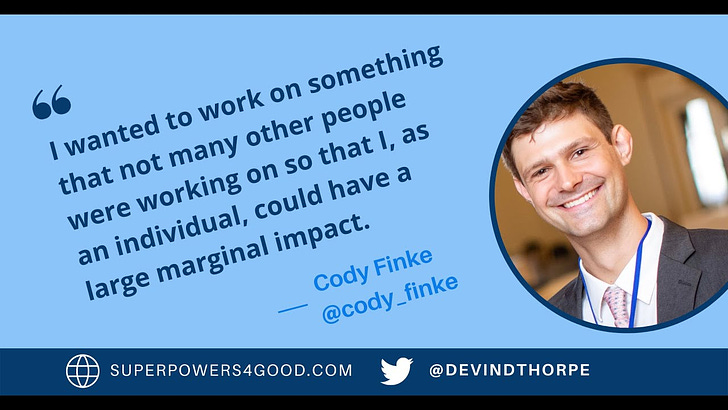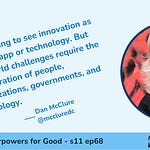Devin: What do you see as being your personal superpower?
Cody: I am a scientist, but I’m also very good at abandoning science that I don’t see a path forward with. And I think that many other folks want to commercialize the science that they’re really passionate about. I’m much more interested in the very, very big picture of greenhouse gas emissions. How do we reduce greenhouse gas emissions? Therefore, if I had to name a superpower related to this, it’s being realistic about whether or not a given chemical process that we’re working on actually has a pathway to being lower cost under an expected or especially current economic system. And under those lower costs, under those scenarios, if it’s also going to be lower emissions and if it’s not that criteria, I’m very good at just abandoning the process and moving on. We had to do that a lot in the early days.
Brimstone Energy, Inc. Founder Cody Finke’s persistent refusal to persist may be the key to his success and critical to finding a path to a global net-zero carbon future.
Cody has repeatedly made significant changes in his path. We’re not talking about pivots; we’re talking leaps.
After being admitted to an extraordinarily prestigious joint MD-PhD program at the University of Southern California and CalTech, he quit. Three months into a program that many would kill to join, he dropped out.
“I didn’t really like medicine,” he says, adding, “I wanted to have a large impact on the health of the planet or the health of people.” He observed that if he dropped out, his spot would be taken by someone equally capable of doing the same work. “Whereas I could go work on a problem that maybe has less traction and be more interesting.”
So, he went to work at CalTech on wastewater treatment for low-income countries for the next three years. At that point, he performed an economic analysis of his work. He recognized that any technology he developed would have to be affordable. It wasn’t.
So, on to the next thing: clean hydrogen. Making hydrogen from water electrolysis is something of a holy grail in cleantech circles. After two years, he began another economic analysis. He concluded that the area he was researching, the catalysts to make hydrogen, was “not a very big lever.” Finally, he observed that “the chances of water electrolysis, in general, being low cost and competing with fossil fuels as an energy source was very remote.”
Looking to make yet another significant shift in his young career, he says, “I wanted to work on something that not many other people were working on so that I, as an individual, could have a large marginal impact.”
He wanted to leverage his developing chemical skill set and settled on cement, which he notes “is a huge greenhouse gas problem, it’s responsible for about the same amount of greenhouse gases as cars.” Most of that carbon, about 60 percent, results from chemistry—not the use of energy to produce the cement.
As Cody set out to develop better Portland Cement (the formal name of the primary ingredient in concrete, which has nothing to do with towns named Portland), he identified three “pillars”:
Economics: Cody wanted to create a product that rational, economic actors would choose.
Carbon neutrality: He wanted to ensure that the new cement would produce less carbon and, if possible, would be carbon neutral.
Identical product: Finally, to avoid needing any regulatory support to make the product work, it had to be demonstrably identical to conventional cement.
While still in pre-commercial development, Brimstone Energy is tracking successfully toward meeting all three goals.
The critical difference is the rock Brimstone uses as the primary source for the lime in concrete—its essential element. Conventional cement is formed using limestone, which contains large amounts of trapped carbon dioxide. When heated to purify the lime, the carbon is released into the atmosphere.
Brimstone Energy starts with a more common rock called calcium silicate—which is much more common than limestone. “We figured out a chemical process to extract the lime from these calcium silicates,” Cody says. “We don’t have any CO2 emissions from the rock, so we’ve totally eliminated that 60 percent of emissions that come from the rock.”
Cody’s new technology still requires heating. Today, a purely economic actor would use fossil fuels to produce the heat. Even so, Cody says, the new cement would be carbon neutral. Credit chemistry. He explains, “Our rock also contains a compound or an element called magnesium. We separate that magnesium as an oxide and magnesium oxides passively absorb CO2.” The effect is large enough to offset the carbon emissions from heating.
Of course, in years to come, the heat can likely be generated from renewable energy, allowing Brimstone Energy’s magnesium oxides to offset other greenhouse gas emissions.
The startup is still operating in the laboratory. The global cement industry produces about 4 billion tons annually. Typical plants make millions of tons. “I would say optimistically we’ll be producing large quantities of cement in five years,” Cody says. “More conservatively, it’ll be ten years or maybe even a little bit longer before we’re producing millions of tons of cement.”
Ultimately, Cody sees the plants as his product rather than the cement. “We think that the fastest way to decarbonizing is to work with all of these companies in order to install our plants for them and hopefully decommission their old plants and install new plants using our process,” he says. “So we’re working on a joint venture licensing business model with conventional producers.”
Getting to this point with the potential to make a dramatic change for the world, Cody has used his superpower, focusing on the economic viability of his science to guide his career.
How You Can Develop Focusing on the Economics of Science As a Superpower
To start, it may seem that this superpower is only relevant if you are a scientist. Elon Musk, who didn’t finish college, let alone a Ph.D., leaps to mind as a counterpoint example. Lots of scientists work for his companies, but he has famously used some Cody-Esque thinking to develop SpaceX and Tesla. Cody’s superpower is relevant to a wide range of changemakers.
One of the fundamental benefits comes with fundraising. “When you go out to raise money, the reason these people are offering you money is because they want to turn their money into more money,” Cody says.
With that framing, Cody has worked to ensure alignment among his investors. Because he is focused on impact and recognizes that scale requires good economics, all his investors are aligned, regardless of whether climate change is a priority or not.
Cody learned this idea from a visiting professor early in his academic career who said, “Science is all about drowning your favorite puppies.” Cody interpreted that to mean, “You’re going to really love the science you’re doing, and you’re going to be really excited about it, and the best thing you can do to figure out is actually a good route is to ask the hard questions and be honest with yourself about those answers.”
To learn and apply these principles, Cody suggests a simple process. Look as objectively as possible at the current economics. He suggests asking, “Given the energy requirements that I’m measuring in the lab, given the cost of that energy that I look up on the internet (not the cost that I imagine with my crystal ball that energy will be in the future), what are the economics of my process looking like just from an energy, raw material and simple capital cost estimate?”
If the numbers don’t look good, Cody concludes, “find a new way to do things.”
By applying these principles, you can make focusing on the economics of science a superpower—even if you aren’t a scientist.
























This Decarbonizing Startup Could Have Huge Impact Due to the Economic Focus of the Founder